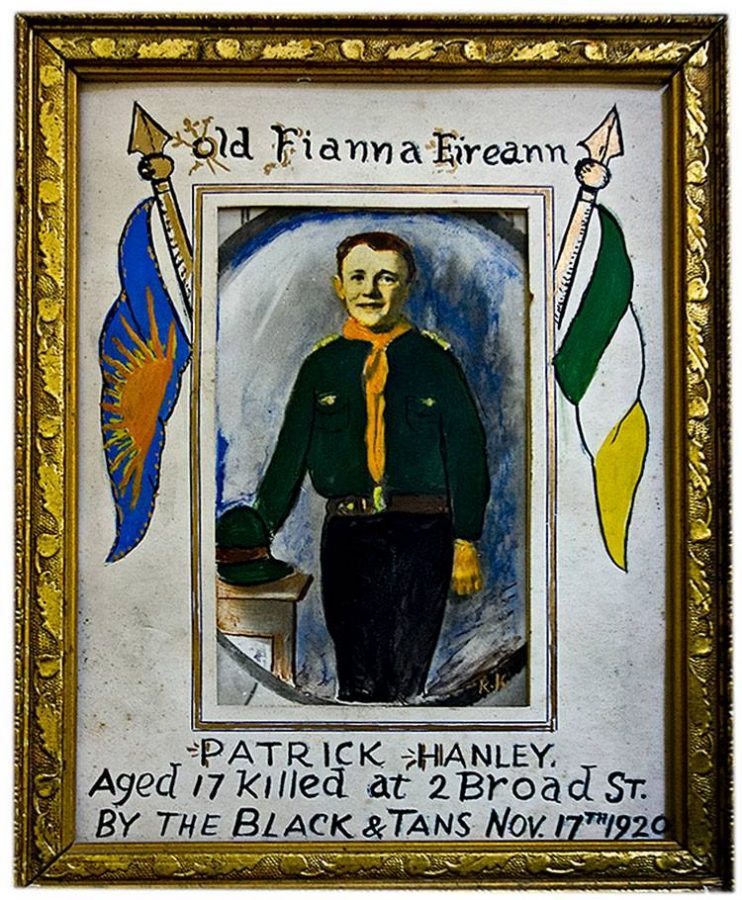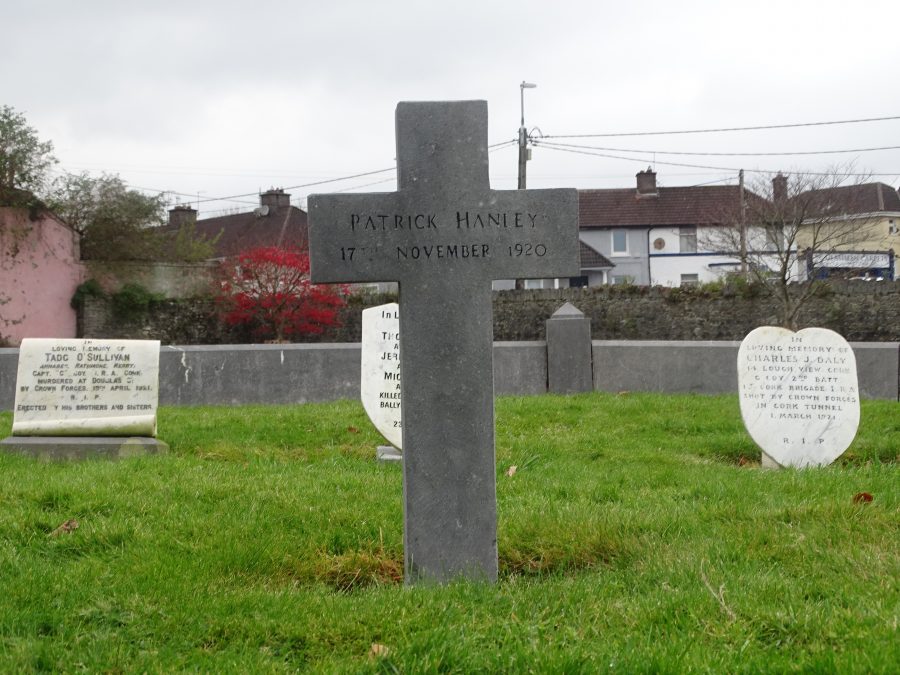
1075a. Portrait of Patrick Hanley 1920 (source: Cork City Library).
Kieran’s Our City, Our Town Article,
Cork Independent, 19 November 2020
Remembering 1920: The Murder of Patrick Hanley
This week coincides with the centenary of teenager Patrick Hanley, who was shot by crown forces on 17 November 1920. George Hurley was a comrade of Patrick within Fianna Éireann or the youth division of Cork IRA Brigade No.1. He recalls the lead-up and incident in his witness statement to the Bureau of Military History (WS1630).
In 1919, the Fianna Éireann headquarters was moved to a private house on Cork’s Pope’s Quay, and, in 1920, to a house on North Main Street. This latter place served as headquarters up to the Truce of July 1921. The training programme of the Fianna consisted of drilling, signalling instruction and lectures in first-aid and in the use of the revolver and rifle. A rifle was used for instruction purposes. Frequent parades took place and on occasions the boys marched out into the country where field training was carried on. A distinctive uniform was worn consisting of a blue short pants, a green shirt with a saffron scarf, and a green broad-brimmed hat.
The use of revolvers was discouraged by the senior organisation of the IRA in the city. A direction was given to the Fianna by headquarters in Cork that the Fianna Éireann was not to carry out any attacks on enemy forces by shooting, unless with the prior permission of the IRA.
The youth division pasted up posters concerning meetings, concerts and public parades. They helped in taking up collections of money for national purposes prisoners’ aid. funds, Sinn Féin election funds and such like. Enemy posters proclamations were torn down.
As time went on and the struggle became more intense in 1920, so also did Fianna Éireann activities increase. They carried out scouting duty and dispatches for the IRA and helped in the removal from suspected places of IRA ammunition and guns. They carried out daylight raids on shops and vans containing provisions and various other goods being dispatched to military barracks in Cork. On several occasions, they held up individual soldiers or Black and Tans and took their equipment.
The murder of Paddy Hanley was by way of a reprisal by the British for the shooting of an RIC sergeant named O’Donoghue by G Company of the IRA earlier on the same night of 17 November 1920 in the course of an IRA raid on Lunham’s bacon factory.
Patrick lived with his widowed mother at No. 2 Broad Street. He was the sole support of her and his sister. At about 11.45 p.m. on the night of 17 November 1920, the residents of No. 2 Broad Street were awakened by the noise of the front door being broken open; a man rushed up the stairs and entered the bedroom of Mr and Mrs Coleman who also resided in the house. The man was wearing a policeman’s uniform, cap and goggles. He came to the bedside with a revolver in one hand and a flash lamp in the other.
When asked by Mrs Coleman what brought him there, he merely exclaimed “Hello”, flashed his lamp on the bed, raised his revolver and fired point-blank into the bed. The bullet wounded Mr Coleman in the arm. The assailant then turned and walked out of the room leaving Mrs Coleman screaming.
Paddy Hanley opened the door of his room when he heard the man rushing up the stairs. The man in police uniform had just come from Mrs Coleman’s room. Whilst standing at the door of his bedroom door, Patrick was fired at. It missed him. The man fired a second time and the bullet struck Patrick above the heart, killing him instantly. He was in his night attire at the time.An ex-British army soldier who lived in Broad Lane was also shot dead.
Leo Buckley, Intelligence Officer with Cork Brigade No.1, was a witness of the shooting (WS1714, Bureau of Military History). At the time, he was sleeping in a top back room of an apartment house in Sheares Street. He recalls that some hours prior to Patrick’s death, an RIC Sergeant had been shot by Tommy Healy and Willie Joe O’Brien of G Company. Tommy and Willie were hiding on Sheares Street. Leo denotes in his witness statement that he felt that Patrick had been shot in mistake for Tommy Healy, while the shooting of O’Brien’s brother-in-law the ex-British army soldier was also a mistake.
In another reprisal raid the same night by the RIC in the Grattan Street, another Fianna boy O’Brien was shot in the mouth. He subsequently recovered from the wound. Volunteer Eugene O’Connell was also killed on the same evening as a reprisal for his part in the murder of the RIC Sergeant. An IRA man suspected of giving information as to who shot the RIC Sergeant was later apprehended and executed by the IRA.
Patrick Hanley’s remains were laid out in his Fianna Éireann uniform in the mortuary of the Mercy Hospital and later removed to the church of SS Peter & Paul. He was buried in St Finbarr’s Cemetery, the tricolour-draped coffin being shouldered all the way to the cemetery by the dead boy’s comrades.
At the Republican Plot there are two memorials to his memory – an individual cross and a marble stone to Fianna Éireann. In addition, on 17 November 1957, a plaque was unveiled by Lord Mayor Jago in memory of Patrick Hanley on Patrick Hanley Buildings on Grattan Street. Eugene O’Callaghan’s headstone can also be viewed in the Republican Plot.
Kieran’s latest book Witness to Murder, The Inquest of Tomás MacCurtain is now available to purchase online (co-authored with John O’Mahony 2020, Irish Examiner/www.examiner.ie).
Captions:
1075a. Portrait of Patrick Hanley 1920 (source: Cork City Library).
1075b. Gravestone of Patrick Hanley in the Republican Plot in St Finbarr’s Cemetery, present day (picture: Kieran McCarthy).
1075c. Remembrance plaque to Patrick Hanley on Grattan Street, Cork, erected in 1957 (picture: Kieran McCarthy).

1075b. Gravestone of Patrick Hanley in the Republican Plot in St Finbarr’s Cemetery, present day (picture: Kieran McCarthy).

1075c. Remembrance plaque to Patrick Hanley on Grattan Street, Cork, erected in 1957 (picture: Kieran McCarthy).